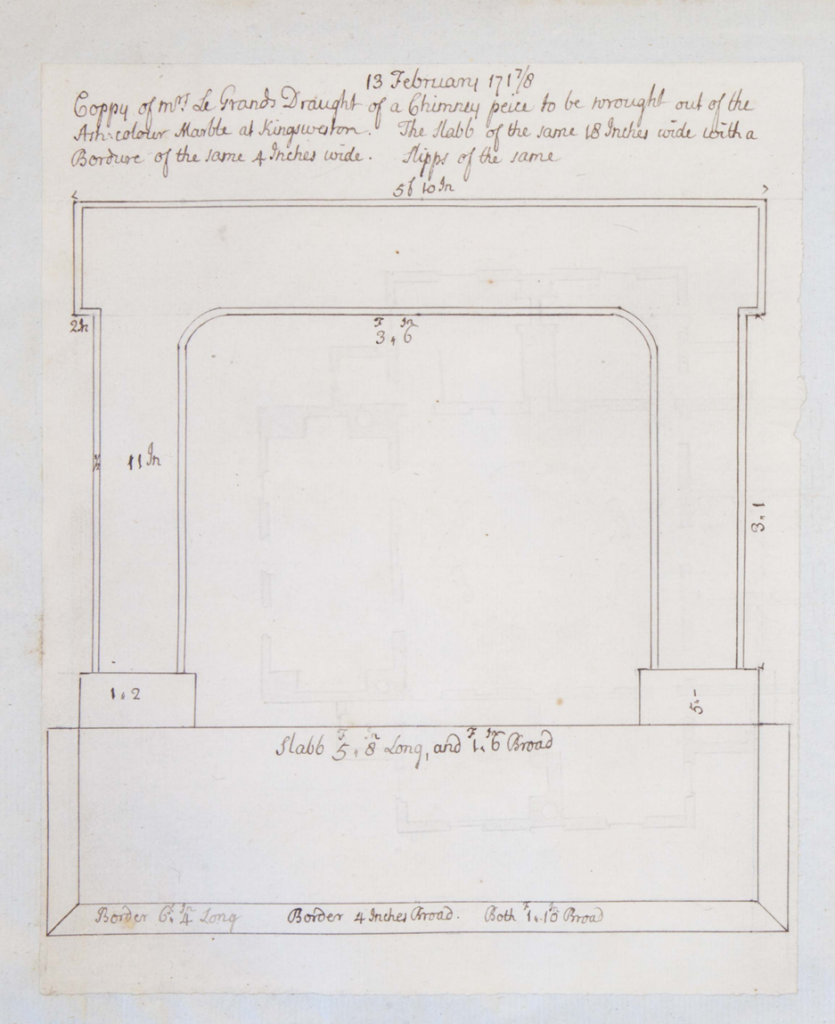It always pays to retrace your steps for something you might have missed before. A recent trip to Bristol Archives and a return to the incredible Kings Weston Book of Drawings led to some small, but interesting discoveries. For those who don’t know of it, it’s a compilation of some of the original architect’s and builder’s drawings for the house, park, and ornamental buildings dating from the first quarter of the Eighteenth Century. It is the source of a lot that underpins our understanding of the work of Sir John Vanbrugh.
First we looked again at a drawing well know to us showing the proposed plan of an octagonal summer house intended for the bottom of Longcoombe in Shirehampton Park, though an option to site it on the top of nearby Conger Hill is also given. This structure may have been that which the second Edward Southwell who owned the estate noted “the seat in Long Combe to be taken away” in 1754.

What we hadn’t spotted before was a tiny pencil sketch, almost invisible now on the margins. Enhancing this tiny doodle revealed it to be an elevation of the same building, suggesting an ornate ogee dome with a spherical finial surmounting it. It’s an oddly proportioned and inelegant proposal on the whole, perhaps a reason for its removal, but equally likely it had decayed sufficiently over thirty years or so to be rendered irreparable.

The book of drawings is full of drawings and sketches unrelated to Kings Weston, so we can be forgiven for having overlooked the significance of an untitled and unannotated elevation of a stone balustrade. Looking again at the drawing we compared it with a painting of the mid 1760s that we discovered some time after our first foray into the book of drawings. Bringing the two together only now did it become clear that the design was for the balustrade that once ran along the north side of the house, protecting people from straying too close to the unprotected edge of the gigantic Great Terrace beyond. It should be noted that this was a separate balustrade from that now protecting the coffee shop terrace; this was only constructed in the mid-Victorian, likely without knowledge of the original arrangement on this side of the house.


Related to the drawing is a memo, also pasted into the book of drawings. This sets out the price for the “rayless and ballisters” at 5 shillings(?) a yard and gives a cost of £15, including bases and pedestals. The note also sends the request that the freemason “desires to know whether hee shall go on with the small potts”; the potts are probably stone urns but their location is not revealed. If you can decipher the accompanying signature, you are a better person than we are!

A final drawing is an intriguing, if tantalising, glimpse of the input of women in the design of elements of Kings Weston, and begs many questions yet to be answered. Helena Le Grand was the sister of Edward Southwell who began the rebuilding of Kings Weston house in 1712. When the house was complete enough for occupation, Edward relied on his sister to organise his affairs before moving in with his second wife, Anne Blathwayte. In August 1716 he wrote “my sister is fully employed in transposing and setting the furniture, pictures and cheney.” Obviously she was a trusted and capable set of hands in such circumstances, but a drawing of a fire surround suggests that she may have had a more direct input in the appearance of the interiors.
The drawing is dated February 1718, when the house was still being finished internally. It is entitled “Copy of Mrs Le Grand’s draft of a chimney piece to be wrought out of the ash colour marble at Kingsweston”. The implication here is that it was Helena who produced the original drawing. It’s not clear whether she was designer, or whether it was in turn a copy of another fire surround, but it’s interesting that it is a scaled drawing, with defined dimensions, and orthogonally drawn; this suggests the Helena clearly shared the skills of a draftsman, and implies that she was closely involved in the design and commissioning aspects of this feature at least. We are left to wonder how much architectural influence she might have had on her brother and his architect?


